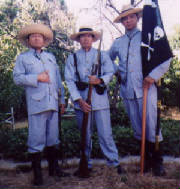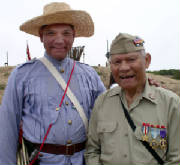 |
The Philippines
The Philippino War took place when the Philippine
Islands were not granted
their independance after the
Spanish-American War. The war lasted from 1899
until 1902, when President Teddy Roosevelt officially
proclaimed the war over
on July 4th. This war was
the first for the United States after becoming a world
power from its victory over
Spain.

|
| The Philippine Forces |
|
 |
Mr. Antonio Ortega is a veteran and survivor of the
Bataan Death March. He had many stories
to tell
about the Philippines, its history, and his life as a
World War II Philippino Scout. Sadly he passed
away in May 2010 in the Philippines.

|
| Mr. Antonio Ortega and his son Raymond |
Wake Island
On
4 July 1898, American forces en route to the Philippines hoist the U.S.
flag over Wake Island, which was vacant at the time. After the war on 17 January
1899, Wake Island was annexed as empty territory by the United States.
|
|
 |
Guam
The
Chamorros, Guam's
indigenous people, first populated the island approximately 4,000 years ago. The
island has a long history of European colonialism. It was discovered by Ferdinand
Magellan during a Spanish expedition on March 6, 1521. The first colony was established
in 1668 by Spain with the arrival of settlers
including Padre San Vitores, a Catholic missionary. For over two centuries
Guam was an important stopover for the Spanish Manila Galleons that crossed the Pacific annually.
The island was controlled by Spain
until 1898.
On 20 June 1898, a U.S. fleet commanded by Captain Henry
Glass, consisting of the armored cruiser USS Charleston and three transports carrying troops to the Philippines, entered
Guam's Apra Harbor. Captain Glass had opened sealed orders that instructed him
to proceed to Guam and capture it. Charleston fired a few cannon rounds at Fort
Santa Cruz without receiving return fire. Two local officials, not knowing that war had been declared and believing the firing had been a salute,
came out to Charleston to apologize for their inability
to return the salute. Glass informed them that the U.S.
and Spain were at war. The following day, Glass sent Lt. William Braunersruehter to meet the Spanish Governor to arrange the surrender
of the island and the Spanish garrison there. Some 54 Spanish infantry were captured
and transported to the Philippines as
prisoners of war. No U.S.
forces were left on Guam, but the only U.S. citizen on the island, Frank
Portusach, told Captain Glass that he would look after things until U.S.
forces returned. Guam was formally ceded to the United States as part of the Treaty of Paris.
|
 |
|
Puerto
Rico
Puerto Rico, which means "rich port"
in Spanish, comprises an archipelago that includes the main island of Puerto Rico
and a number of smaller islands, the largest of which are Vieques, Culebra, and Mona. Originally
populated for centuries by indigenous aboriginal peoples known as Taínos, the island was claimed by Christopher Columbus for
Spain during his second voyage to the Americas on November 19, 1493. Under
Spanish rule, the island was colonized and the indigenous population was forced into slavery.
The Taínos were nearly wiped out due to European infectious diseases. The
remaining population was emancipated by King Charles I in 1520. Spain possessed Puerto Rico for over 400 years, despite attempts at capture of the island by
France, the Netherlands,
and England.
In
May 1898, Lt. Henry H. Whitney of the United States Fourth Artillery was sent to Puerto Rico
on a reconnaissance mission, sponsored by the Army's Bureau of Military Intelligence. He
provided maps and information on the Spanish military forces to the U.S.
government prior to the invasion. On May 10, U.S. Navy warships were sighted
off the coast of Puerto Rico. On May 12, a squadron
of 12 U.S. ships commanded by Rear Adm. William T. Sampson bombarded San Juan. During the bombardment,
many government buildings were shelled. On June 25, the USS Yosemite
blockaded San Juan harbor.
On July 25, General Nelson A. Miles, with 3,300 soldiers, landed at Guánica, beginning the Puerto Rican Campaign. The troops faced resistance early in the invasion. The
first skirmish between the American and Spanish troops occurred in Guánica. The
first organized armed opposition occurred in Yauco in what became known as the Battle of Yauco. This encounter was followed by the Battles of Fajardo, Guayama, Guamaní
River Bridge, Coamo, Silva Heights and finally by the Battle of
Asomante. Spain, under the terms of the Treaty of Paris of 1898, ceded the island to the United States.
|
|



